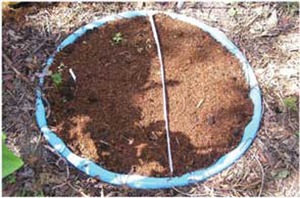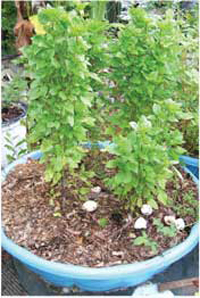 |
||||||||

Water-Wise Containers – An Eco-Friendly Solution for Frugal Gardeners
By John Starnes
 Photos by John Starnes
Photos by John Starnes
A baby pool with drip irrigation is ready to plant with winter greens. Many greens, including those that can be very expensive in grocery stores, are easy to grow from October to March. Most will handle cold weather without significant damage and some even like an occasional freeze.

Larger vegetables, like tomato plants or the enormous basil shown here, thrive in "repurposed containers."
The lush wet Florida where I gardened during the 1960s is gone, replaced by perennial drought and watering restrictions. When state guidelines recommend avoiding the use of reclaimed water on vegetables, what can a
frugal gardener do?
Water-wise containers made with "re-purposed" plastic containers are my solution to that conundrum. You can grow an enormous amount of food in a very small space – and use even less water. Despite the fact that I grow much of the food I eat, as well as care for an extensive collection of heirloom roses, my March water bill was just $3.84.
For a bountiful harvest of greens, start with a three-foot diameter blue plastic baby or doggy pool, and drill about a dozen ¼" holes from the inside, one inch up from the bottom. Fill it with soil and compost and presto, you have an ideal spot for a winter salads garden.
For larger plants, drill five ½-inch holes in a five-gallon bucket three inches from the bottom, then fill with soil and compost. You'll have a perfect pot for growing a tomato plan each winter — plus it will be easy to bring inside during a freeze.
What happens with these homemade pots is that the layer of soil below the drainage holes tends to stay damp, and the holes themselves allow for crucial airflow to the roots at night. This approach is vastly more effective — and cheaper — than the famous self-watering containers that often end up with three inches of water standing inside their base going sour and anaerobic, sickening or often killing the plants. Those that have a plastic sheet covering the soil worsen this problem by further blocking air flow through the soil.
Nutrients, of course, will be critical in such a small container. A light sprinkling of dolomite worked into the soil will combat excess acidity while providing calcium and magnesium. I also use Alaska Fish Fertilizer, 3 tablespoons per gallon, as a soil drench once a month. Don't allow the drench to overflow the pot — the fertilizer that supports your healthy vegetables will fuel the growth of alga if it escapes into a nearby body of water. Look for the baby pools on sale each fall at Babies-R-Us for about $5, or doggy pools year round for about $10.
Gardening this way the last few years has drastically slashed my water bill, and students who've taken my classes on Water Wise Container Gardening report great success after struggling to garden in this sandy soil. It's cheap, it works, give it a try!
John Starnes, profiled in the Fall 2008 issue of Bay Soundings, is a Florida Gardening columnist who grows most of his own food on a south Tampa lot. He opens his garden to classes on an irregular schedule on weekends during the Fall and Winter. For more information, email him at johnastarnes@msn.com or call him at 813-839-0881.
